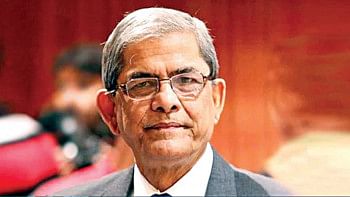On a foggy Narsingdi road

NARSINGDI had its share of battles during the long nine months of the Liberation War. Many fighters of the Mukti Bahini were lodged in the deep forests and villages on the two sides of the 30 km road starting at Tarabo, Rupganj. The freedom fighters had ambushed Pakistani troupes, Razakar camps and militias, and even blew up some important bridges over this period. The destruction of the big iron bridge at Pachrukhi Bazaar was vital for the Bahini, as heavy army vehicles were forced to stop plying the road because there was no other detour in the area.
Here is an excerpt taken from the website of Bangladesh Sangbad Sangstha (BSS) on the contribution of Narsingdi to our Liberation War as narrated by local commanders and organisers: “On March 25, over 3,000 rebel EPR soldiers, Ansar and police reached Narsingdi by launches. A huge quantity of arms and ammunition also reached the place by train. Captain Motiur Rahman received the arms. About 1000 youths and students took up the arms and started crossing the border for training. The Pakistani forces on April 4 and 5 carried out air attacks on different places of the district. About 200 helpless men, women and children died in indiscriminate attacks. But the killing could not dampen the spirit of the freedom loving people of Narsingdi.”
The first guerrilla encounter took place in Bagbari and Palbari near Madhobdi on April 14 when the Pakistani forces were trying to occupy Narsingdi by land routes. The local forces and freedom fighters resisted the invading forces, reports the BSS article. “After one day, the Pakistani forces again attacked the freedom fighters and in face of heavy bombing, the freedom fighters were compelled to retreat from their position. And as a result, Pakistani forces were able to set up camps in different places of the district. During the nine-month war, the Pakistani forces killed many people in the district town and its adjacent areas and dumped the bodies of the victims in the River Meghna.”
A pitched battle took place between freedom fighters and Pakistani forces at Nilkutthi beside Arial Khan River in Belabo upazila in the last week of November, where 35 people, including Subader Abul Bashar, Momotaz Uddin, Abdus Salam, Abdul Hoque and Abdul Bari embraced martyrdom. They were buried on the bank of Arial Khan River, informs the article.
“Narsingdi was liberated from the occupation forces in the last battle on December 12. Freedom fighters attacked the Pakistani army on the night of December 10. At one stage, they cordoned off the main enemy camp from all sides. After failing to face the massive attack, the Pakistani forces surrendered without fighting on December 12.”
The air in the adjacent villages since the full-fledged war started on December 3 was filled with the smell of burnt gunpowder. Fear of what would happen next made everyone nervous and apprehensive. They kept their eyes glued on the Narsingdi road to keep a check on the movements of the Pakistani troops. Some courageous young men had climbed up tall trees in an attempt to see battles being fought in the distance but the fog came in the way. Some daredevils had crawled all the way to the Meghna River and from a safe distance, watched the Indian tanks crossing the river under heavy enemy fire. One could see helicopters strafing Pakistani positions on this side of the bank.
The Pakistani army had been on the retreat from their well-fortified positions in Narsingdi, especially on the bank of the river, since December 12, when the joint forces comprising the Indian army and Mukti Bahini boys destroyed most of the fortifications. Columns of Indian army personnel and Mukti Bahini boys were evading the main battlefields in Narsingdi and marching on foot through the winding roads deep inside the villages, to reach Dhaka through Demra.
On December 12, some Pakistani troops were trying to take their troop carriers loaded with heavy weapons across a hastily installed pontoon over a small canal underneath the collapsed Pachrukhi bridge. When Mukti Bahini guerrillas informed some Indian commanders nearby about this plan, they sent a helicopter to bombard the area. They hit the troop carrier and blew it to smithereens.
On December 12, with the fall of Narsingdi, Indian helicopters carried parts of big artillery guns to Tarabo river bank. Indian artillery regiments assembled them on site and aimed it towards Dhaka city as they prepared for the much anticipated 'Battle for Dhaka'.
On December 13, the Narsingdi road wore a totally different look. Instead of Pakistani troop carriers and their field guns, dozens and dozens of Indian army vehicles of every denomination were seen rumbling towards Demra with hundreds of soldiers marching on foot. Hundreds of Mukti Bahini boys also marched along, invigorated by the fall of the Pakistan army in Narsingdi and retreat of the army. It was a sight never to be seen again in one's lifetime.
On December 16, as the first rays of the sun filtered through a heavy fog, the booming sounds of heavy field guns had stopped and all that came from the direction of Narsingdi was the occasional burst of light machine guns and small arms; the last minute clearing of fox holes. At one point, it all ended. Suddenly the silence, the pent up fear, the hidden tears, the hatred - all swelled up in the hearts of combatants and civilians alike, with a force more intense than any bomb ever detonated. It took many hours for people to absorb the fact that the blood-licking hyenas had retreated into the darkness forever and the much cherished freedom was finally theirs. The tears came easily, but these were tears of joy and relief. Bangladesh was finally a reality.
The writer is Special Supplements Editor, The Daily Star.


 For all latest news, follow The Daily Star's Google News channel.
For all latest news, follow The Daily Star's Google News channel. 



Comments